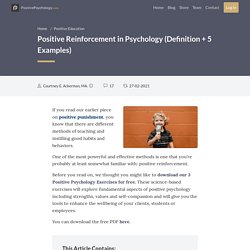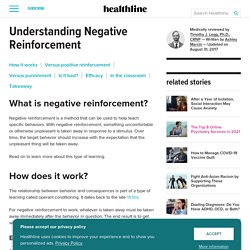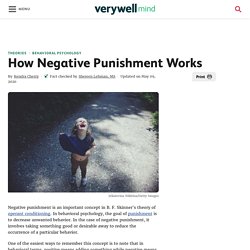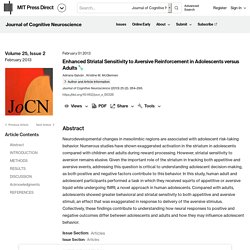

Although this experimentation with autonomy creates opportunities for them to develop decision-making skills, it also poses risks as teenagers are predisposed towards overvaluing the benefits of an activity (cite).
In this resource centre, we will detail how operant conditioning can be used to influence behaviour of teenagers.
Explaining Risk-Taking Behaviour in Adolescence. 4 Types of Operant Conditioning. What is Positive Reinforcement?
If you read our earlier piece on positive punishment, you know that there are different methods of teaching and instilling good habits and behaviors.

One of the most powerful and effective methods is one that you’re probably at least somewhat familiar with: positive reinforcement. Before you read on, we thought you might like to download our 3 Positive Psychology Exercises for free. These science-based exercises will explore fundamental aspects of positive psychology including strengths, values and self-compassion and will give you the tools to enhance the wellbeing of your clients, students or employees. You can download the free PDF here. What is the Meaning of Positive Reinforcement? Positive reinforcement refers to the introduction of a desirable or pleasant stimulus after a behavior.
The Psychology of Positive Reinforcement Theory Although it sounds like a simple idea, it was not always the “go-to” method for teaching. A Brief Look at B.F Skinner and His Operant Conditioning Model 1. 2. Effectiveness of Positive Reinforcement. 4 Types of Positive Reinforcers. Examples of Positive Reinforcement. What is Negative Reinforcement? What is negative reinforcement?

Negative reinforcement is a method that can be used to help teach specific behaviors. With negative reinforcement, something uncomfortable or otherwise unpleasant is taken away in response to a stimulus. Over time, the target behavior should increase with the expectation that the unpleasant thing will be taken away. Read on to learn more about this type of learning. The relationship between behavior and consequences is part of a type of learning called operant conditioning.
For negative reinforcement to work, whatever is taken away must be taken away immediately after the behavior in question. Examples A person hears a loud alarm. Before behavior: Loud alarmBehavior: Person turns alarm offAfter behavior: No more annoying soundFuture behavior: Person pushes STOP every morning to quiet alarm Parents complain to their child when the child doesn’t clean their room.
Effectiveness of Negative Reinforcement. Examples of Negative Reinforcement. What is Positive Punishment? Positive punishment is a form of behavior modification.

In this case, the word “positive” doesn’t refer to something pleasant. Positive punishment is adding something to the mix that will result in an unpleasant consequence. The goal is to decrease the likelihood that the unwanted behavior will happen again in the future. This approach may be effective in certain circumstance, but it’s only one part of the equation. Guiding your child toward alternative behaviors that are more appropriate to the situation are also needed. Let’s take a look at positive punishment and how it compares with negative punishment and positive and negative reinforcement. All actions have consequences. For example, if your child eats whipped cream that has spoiled because they hid it under their bed, they’ll get a stomachache.
These experiences are unpleasant at best. When choosing a punishment, think about punishing the behavior, not the child. Scolding. Effectiveness of Positive Punishment. Examples of Positive Punishment. What is Negative Punishment? Negative punishment is an important concept in B.

F. Skinner's theory of operant conditioning. Effectiveness of Negative Punishment. Examples of Negative Punishment. The Importance of Balance between Reinforcement and Punishment. Adolescents’ unique sensitivity to rewards is thought to be due to increased activity in and communication between areas of the brain that respond to rewards.

However, we also know that many of the same brain areas also respond to punishment and that there are dynamic changes occurring throughout the brain during adolescence. Much like the complexity of brain development, the story about how adolescents learn from reinforcement might not be so simple. “The way that adolescents learn from the choices that they have made in the past will ultimately influence their future choices and actions.”
An in-depth review of studies examining how we learn from reinforcement across age shows mixed results. Contrary to the idea that adolescents may learn best from rewards, some studies find that adolescents actually learn more from punishment. The context in which learning takes place may be key. Studies conducted to date have subtly varied the learning context in different, specific ways. Effects of Punishment on Adolescents. Our goal in the current study was to focus on neural differences in the striatum, given its role in processing both positive and negative events (Levita et al., 2009; Jensen et al., 2003).

Physiological studies have shown that different neurons in the nucleus accumbens respond to both aversive and appetitive stimuli (Roitman, Wheeler, & Carelli, 2005; Wilson & Bowman, 2005; Setlow, Schoenbaum, & Gallagher, 2003; Yangimoto & Maeda, 2003). Specifically, elevated dopamine levels are observed in the accumbens in response to various aversive outcomes, including electric shocks, restraint stress, and anxiogenic drugs (Young, 2004; Kalivas & Duffy, 1995; Robinson, Becker, Young, Akil, & Castaneda, 1987).
This region plays an important role in aversive conditioning and avoidance behavior in nonhuman animals (Hoebel, Avena, & Rada, 2007; Schwienbacher, Fendt, Richardson, & Schnitzler, 2004). We speculate that these novel findings have important implications for adolescent decision-making. Conclusion.